xxx
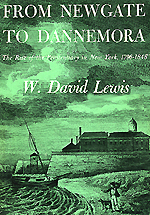
xxx
NYCHS presents excerpts from From Newgate to Dannemora: The Rise of
the Penitentiary in New York, 1796-1848, by W. David Lewis.
Copyright © 1965 by Cornell University; copyright renewed 1993.
Used by permission of the author and the publisher, Cornell
University Press. All rights reserved. Click on image, based on book jacket front cover, to access Cornell University Press site.
|
|
Chapter I: Heritage (Part III)
(Excerpted from Pages 20 through 28)
. . . . A noted
Anglican divine, Thomas Bray, reported on wretched jail conditions to the Society for Promoting Christian Knowledge at the
turn of the eighteenth century . . . . Bray recommended official inspections; the prohibition of liquor and wine; the abolition of such
old customs as garnish and chummage, under which incoming inmates were compelled to part with either their money or their
clothing; segregation of the sexes; the separation of old from young
offenders; systematic labor; and the promulgation of specific prison
rules.
Bray also suggested that inmates who behaved well should
be aided in finding employment after release. Although these ideas were too much in advance of their time to
be adopted, Bray’s work was carried on by his friend and associate
James Edward Oglethorpe, who headed a parliamentary committee
which exposed vile conditions existing in various debtors’ prisons
in 1729 and 1730. . . .
The concern of Bray and Oglethorpe for imprisoned
debtors also helped lead to the establishment of the American colony of Georgia in 1732.
xxx
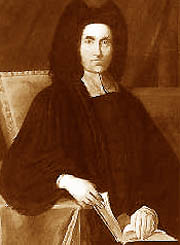 The Rev. Thomas Bray image above and the James Edward Oglethorpe image below do not appear in From Newgate to Dannemora. The Bray image appears on the web site of Society for Promoting Christian Knowledge (SPCK). The Oglethorpe image appears on the web site of National Park Service (NPS).
Clicking the Bray image accesses a SPCK history about the society's formation in 1698 to continue the Anglican priest's various projects in England while he visited Maryland. Clicking the Oglethorpe image accesses an NPS page on Georgia history that includes his role in founding the colony after his having been moved by the plight of a friend who died in an English debtors' prison,
xxx
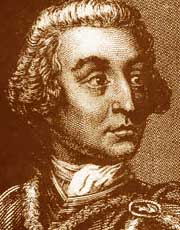
|
|
As the work of Bray and Oglethorpe shows, the shortcomings of
English prisons troubled an occasional Anglican churchman.
Of
more importance for British and American penal reform, however,
were the efforts of various reformers who belonged to the Society
of Friends.
Like William Penn, who was imprisoned three times
prior to the founding of Pennsylvania, many Quakers had learned
at first hand the terrors of confinement in typical English jails.
Their belief in the doctrine of the “inner light” led them to seek
not only to better prison conditions but also to convince their
contemporaries that the aim of penal treatment should be to
reform rather than to punish.
A good example of an early Quaker prison reformer was John
Bellers, a cloth merchant.
Bellers . . . advocated strict regulation of
prisons, suitable employment for inmates, restrictions upon the
selling of intoxicating drinks in jails, and an end to the practice
of allowing wealthy prisoners to buy special indulgences. . . .
Bellers knew
William Penn and probably had a direct influence upon the Proprietor’s thinking. . . .
William Eden overcame his previous objections to prisons and because a convert to Howard’s ideas, as did
Sir William Blackstone
Together these two men drafted comprehensive legislation authorizing the construction of national penitentiaries, the use of hard labor within them, the provision of
proper food and clothing for inmates, and the maintenance of
strict institutional discipline.
Passed by Parliament in 1779, the
Hard Labour Act['s] promising prospects did not materialize . . .
The new measure . . . aroused
opposition from a number of persons who pointed out that it permitted convicts to work together during the daytime and thus gave
them a chance to corrupt one another.
xxx
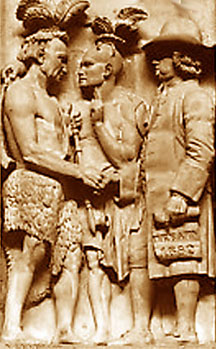
xxx
The above Wm Penn treaty image -- based on the 1827 sandstone U.S. Capitol Rotunda frieze by Nicholas Gevelot (over north door) --
does not appear in From Newgate to Dannemora. Clicking the image accesses the Architect of the Capitol web page where the uncropped original grayscale image appears. Penn, whose Quaker activities led to his being jailed thrice, became one of America's earliest champions of religious freedom. His famed Liberty of Conscience treatise was written while "a Prisoner for Conscience-Sake" in London's Newgate Prison 1670.
|
|
Thus was provided a preliminary airing of an issue which split nineteenth century prison
reformers into opposing camps and provided the basis for the
bitter disputes which took place between adherents of the Auburn
and Pennsylvania systems.
Howard believed
that it was necessary to separate convicts at night.
He was nevertheless willing to allow group employment by day, possibly because
he thought that adequate techniques of supervision could be
devised and believed that joint labor would be economically
advantageous. . . .
Another champion of utter solitude was Sir George Paul, later
to become a significant penal administrator and pioneer in the
building and management of Gloucester Penitentiary.
Paul believed in the reformability of criminals, but held that this was
best accomplished by preventing any contact between prisoners.
The most prominent advocate of strict solitary confinement,
however, was probably Jonas Hanway . . . .
In 1776, three years before the
passage of the “Hard Labour Act,” Hanway laid down a plan for
a model institution which would ensure the complete isolation of
its inmates. Here, about fifty years before the building of the
Eastern State Penitentiary in Philadelphia, was a vision of how to
implement what later became famous as the Pennsylvania system. . . .
xxx
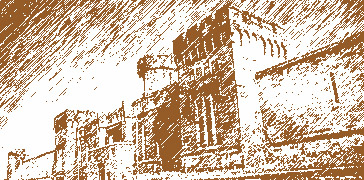
xxx
The Eastern State Penitentiary images above and below do not appear in From Newgate to Dannemora but do appear elsewhere on this web site in an NYCHS excerpts presentation of On the Penitentiary System in the U.S. and Its Application in France by Gustave de Beaumont & Alexis de Tocqueville. Clicking either image accesses that page.
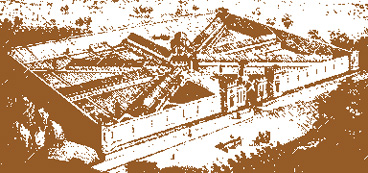
xxx
|
|
The extent to which the opposition of such men as Hanway
contributed to the failure of the “Hard Labour Act” is only conjectural.
Doubtless the dissension that prevailed in the committee
charged with executing the law was partly responsible for the fact
that the statute was not effectively implemented.
While reformers
quarreled the government sidestepped the controversy and resorted to such expedients as brutalizing and pestilential prison
ships or to the old remedy of deportation, this time to Australia.
A second penitentiary act was passed in 1791, but its provisions
were permissive and it could not be enforced.
Three years later,
Parliament endorsed Bentham’s Panopticon system, but difficulties
involving the selection of a site and the purchasing of land wrecked
the project and made it one of the most disappointing episodes of
the utilitarian philosopher’s career.
Further action to establish a
penitentiary system was not taken until after the end of the Napoleonic Wars, when construction was begun on Millbank prison. . . .
|
Table of Contents
|
- [Book jacket blurb, images]
- Preface
- The Heritage
- The First Experiment
- The Setting for a New Order
- The Auburn System and Its Champions
- Portrait of an Institution
- The House of Fear
- The Ordeal of the Unredeemables
- Prisons, Profits, and Protests
- A New Outlook
- Radicalism and Reaction
- Ebb Tide
- Change and Continuity
- A Critical Essay on Sources
|
|
Like the British
Hard Labour Act, the French [prison reform] law of 1791 passed into oblivion;
the vicissitudes of war and revolution provided an inhospitable
atmosphere . . . .
Even in Ghent, discipline deteriorated at the celebrated Maison de Force, and the practice of keeping inmates separated at night was discontinued . . . .
In looking hack over the evolution of penal methods in Europe, therefore, it becomes clear that the United States was less the
originator of the penitentiary system than the recipient of a long
tradition which European countries carried to the point of climax
but failed to culminate.
While the Napoleonic Wars raged in the
Old World, leadership in correctional matters passed to America
more or less by default.
But this in no way diminishes the importance of what was achieved in the United States. In building upon
European precedents, making a pragmatic test of theories originally conceived across the Atlantic, and from time to time adding
new ideas and techniques of their own, American reformers made
a noteworthy contribution to the development of modern penology.
With the construction of Newgate prison under way in 1796, Thomas Eddy and his fellow New Yorkers took their place beside
Pennsylvania humanitarians in the vanguard of this significant
effort.
|
